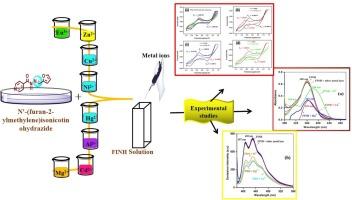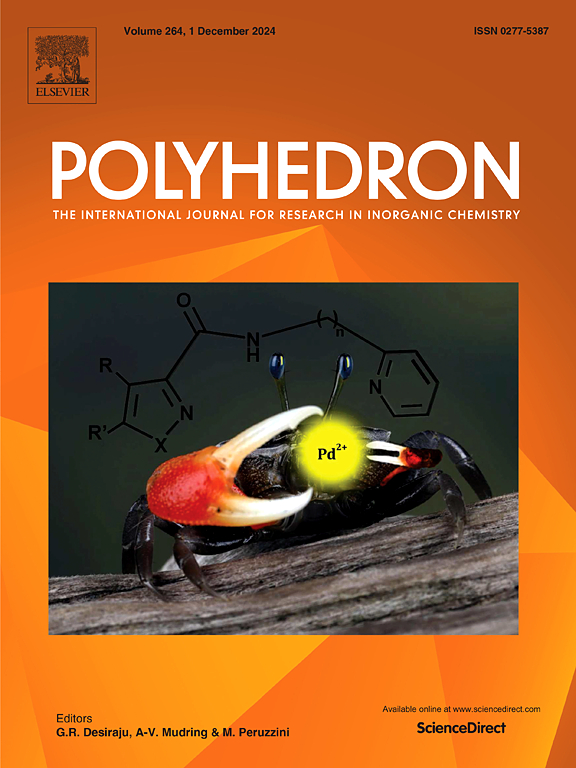An Isoniazid-Based reversible Schiff base chemosensor for Multi-Analyte (Cu2+, Ni2+, Hg2+) detection
IF 2.4
3区 化学
Q2 CHEMISTRY, INORGANIC & NUCLEAR
引用次数: 0
Abstract
Isoniazid-based Schiff base N’-(furan-2-ylmethylene)isonicotinohydrazide (FINH) has been synthesized. FINH has proven its ability to selectively sense and respond to Cu2+, Ni2+, and Hg2+, which shows its potential as a chemosensor. UV–visible experiments, the absorption band (at 360 nm) of FINH shifted with the gradual addition of Cu2+, Ni2+, and Hg2+. A significant quenching in the emission band of FINH in fluorescence spectra has been observed with the addition of analytes at the physiological pH range. Cyclic voltammetric experiments have been conducted to determine the electron transfer process that occurs during the complexation of FINH with analytes. Moreover, the interactions of FINH-metal ions are reversible, and their reversible behavior has been demonstrated with the Na2EDTA solution. The binding insights among FINH and Cu2+, Ni2+, and Hg2+ are explained by IR spectral study. Additionally, the FINH works within the appreciable detection limit of 9.472 x 10−7 M (for Cu2+), 7.685 x 10−7 M (for Ni2+) and 2.411 x 10−7 M (for Hg2+), limit of quantitation of 3.15 x 10−6 M (for Cu2+), 2.561 x 10−6 M (for Ni2+) and 8.036 x 10−7 M (for Hg2+). Applying this isoniazid-based reversible chemosensor in analyzing real samples demonstrates its practicality and effectiveness for multi-analyte detection. This sensor could consistently measure metal ion concentrations in various environmental and biological samples, providing a valuable tool for monitoring pollutants and evaluating exposure risks.

一种基于异烟肼的可逆席夫碱化学传感器,用于检测多种分析物(Cu2+、Ni2+、Hg2+)。
基于异烟肼的希夫碱 N'-(呋喃-2-基亚甲基)异烟酰肼(FINH)已被合成。事实证明,FINH 能够选择性地感知并响应 Cu2+、Ni2+ 和 Hg2+,这显示了其作为化学传感器的潜力。在紫外可见光实验中,随着 Cu2+、Ni2+ 和 Hg2+ 的逐渐加入,FINH 的吸收带(360 纳米)发生了移动。在生理 pH 值范围内,加入分析物后,荧光光谱中 FINH 的发射带明显淬灭。为了确定 FINH 与分析物络合时发生的电子转移过程,我们进行了循环伏安实验。此外,FINH 与金属离子的相互作用是可逆的,其可逆性已在 Na2EDTA 溶液中得到证实。红外光谱研究解释了 FINH 与 Cu2+、Ni2+ 和 Hg2+ 之间的结合关系。此外,FINH 的检测限分别为 9.472 x 10-7 M(Cu2+)、7.685 x 10-7 M(Ni2+)和 2.411 x 10-7 M(Hg2+),定量限分别为 3.15 x 10-6 M(Cu2+)、2.561 x 10-6 M(Ni2+)和 8.036 x 10-7 M(Hg2+)。将这种基于异烟肼的可逆化学传感器应用于实际样品分析,证明了它在多种分析物检测方面的实用性和有效性。这种传感器可持续测量各种环境和生物样本中的金属离子浓度,为监测污染物和评估暴露风险提供了一种宝贵的工具。
本文章由计算机程序翻译,如有差异,请以英文原文为准。
求助全文
约1分钟内获得全文
求助全文
来源期刊

Polyhedron
化学-晶体学
CiteScore
4.90
自引率
7.70%
发文量
515
审稿时长
2 months
期刊介绍:
Polyhedron publishes original, fundamental, experimental and theoretical work of the highest quality in all the major areas of inorganic chemistry. This includes synthetic chemistry, coordination chemistry, organometallic chemistry, bioinorganic chemistry, and solid-state and materials chemistry.
Papers should be significant pieces of work, and all new compounds must be appropriately characterized. The inclusion of single-crystal X-ray structural data is strongly encouraged, but papers reporting only the X-ray structure determination of a single compound will usually not be considered. Papers on solid-state or materials chemistry will be expected to have a significant molecular chemistry component (such as the synthesis and characterization of the molecular precursors and/or a systematic study of the use of different precursors or reaction conditions) or demonstrate a cutting-edge application (for example inorganic materials for energy applications). Papers dealing only with stability constants are not considered.
 求助内容:
求助内容: 应助结果提醒方式:
应助结果提醒方式:


